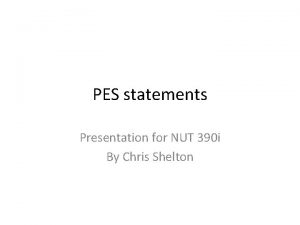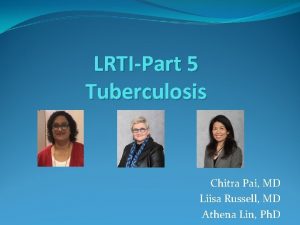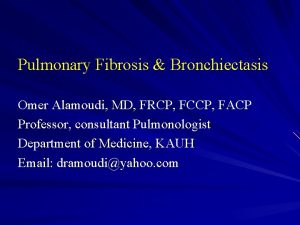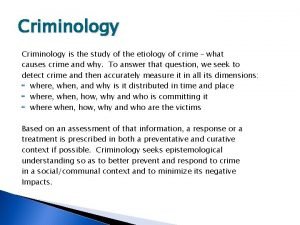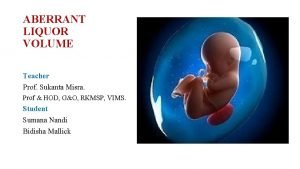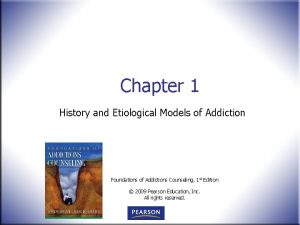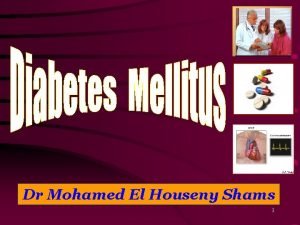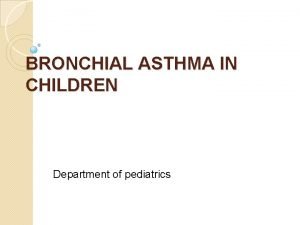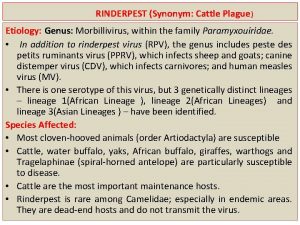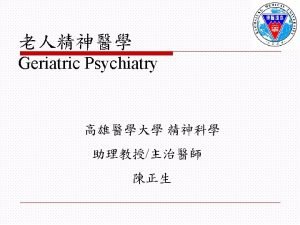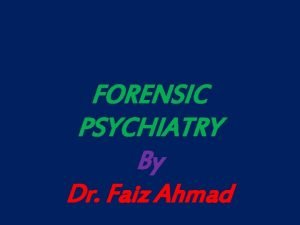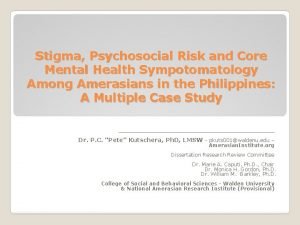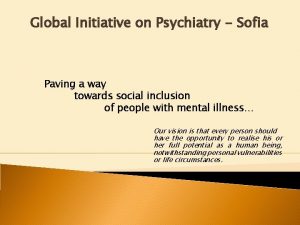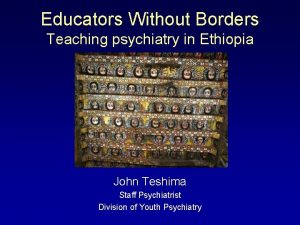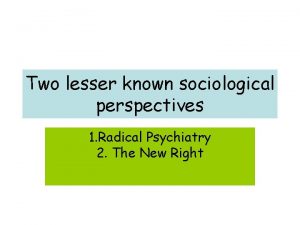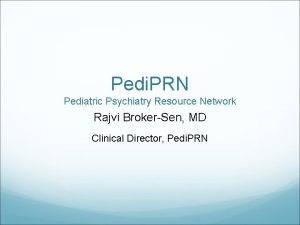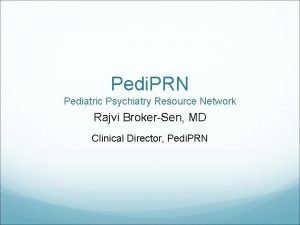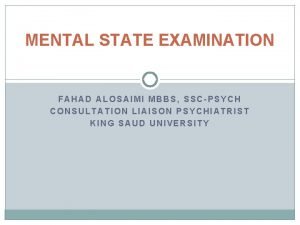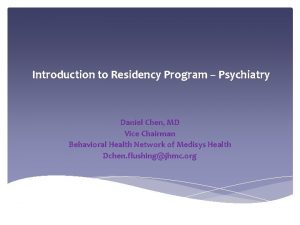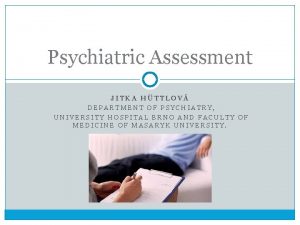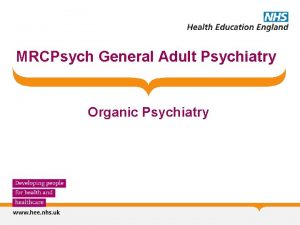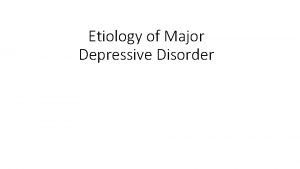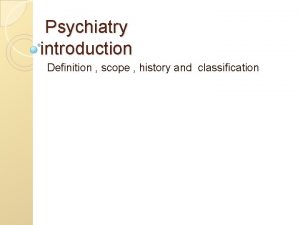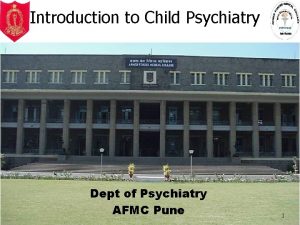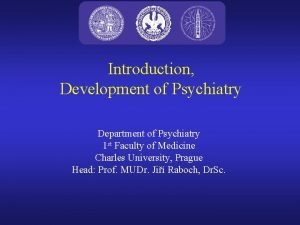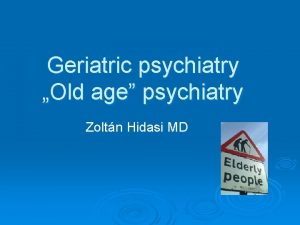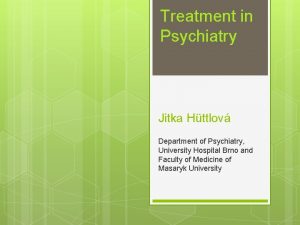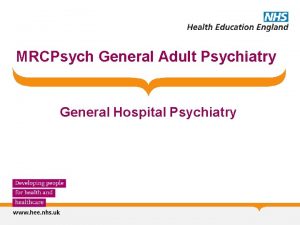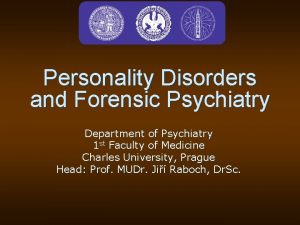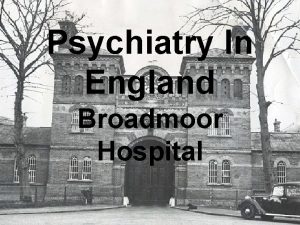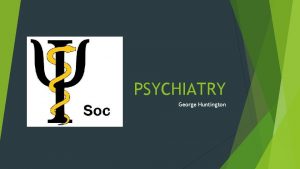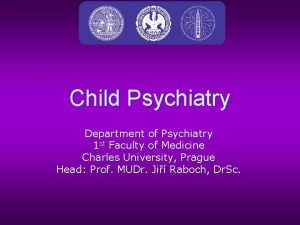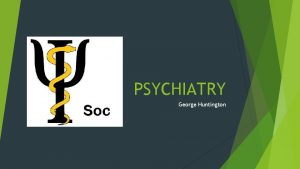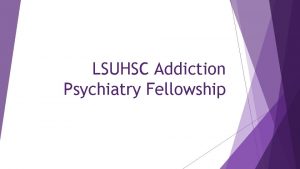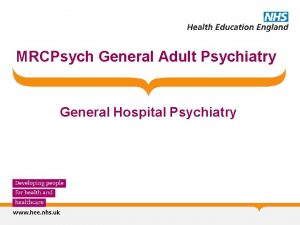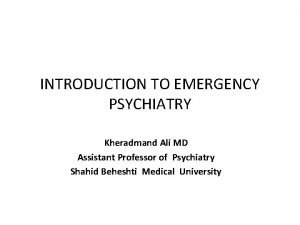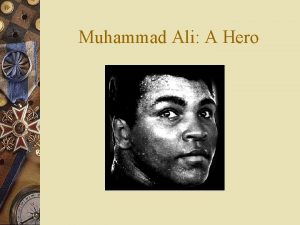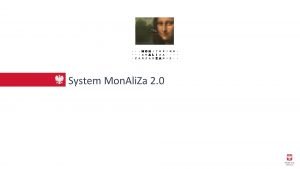ETIOLOGY IN PSYCHIATRY CLASSIFICATIONDIAGNOSIS IN PSYCHIATRY Dr Ali






























- Slides: 30

ETIOLOGY IN PSYCHIATRY, CLASSIFICATION/DIAGNOSIS IN PSYCHIATRY Dr. Ali Bahathig, FRCPC, Assistant Professor and Consultant of Psychiatry & Psychosomatic Medicine Psychosomatic Unit, Psychiatry Department King Saud University Medical City (KSUMC) 1440/1441 2019/2020

SPECIAL TAHNKS TO: 1. Dr. Fahad Alosaimi, MD, Professor and Consultant of Psychiatry & Psychosomatic medicine, College of Medicine, King Saud University 2. Dr. Ahmad Alhadi, MD, Associate Professor and Consultant of Psychiatry and Psychotherapy, College of Medicine, King Saud University 3. Dr. Mohammed Al-Sughayir, MD, Professor and Consultant of Psychiatry, College of medicine, King Saud University

Objectives: Ø To discuss the etiology of psychiatric disorders. Ø To list the main classification systems for Diagnosis in psychiatry. Ø To discuss the differences between ICD & DSM Ø To describe the differences between primary and secondary psychiatric disorders. Ø To describe the differences between psychosis and neurosis.

Etiology: Ø The Complexity of etiological factors: 1. Time factors: Ø Causes are often remote in time from the effect they produce. 2. Single cause: Ø May lead to several psychological effects e. g. deprivation from parental affection may lead to depression or conduct disorder in children and adolescents. 3. Single effect: Ø May arise from several causes e. g. depression may be due to accumulation of several causes like endocrinopathies, psychosocial stresses, and side effects of some drugs. M. Al-Sughayir – Manual of Basic Psychiatry

Etiology in Psychiatry: Ø Like other branches of Medicine, etiology of primary psychiatric illnesses is usually multifactorial Ø Etiological factors can be classified into biological, psychological, and social factors: Bio-Psycho-Social Approach (Engel 1977) Biological Factors Social Factors Psychological Factors

Biological Factors Psychological factors Social Factors v Genetic: e. g. in schizophrenia v Thinking distortions v Neuropathological: e. g. dementia v Emotional dysregulation support, criticism, and v Endocrinological: e. g. v Behavioral problems over protection within the family. hyper/hypothyroidism v Biochemical: the monoamine neurotransmitters. v Pharmacological: side effects of medications e. g. steroids v Metabolic: DM v Inflammatory/ autoimmune v Unconscious conflicts v Others v Family factors: lack of social v Life events : Migration, unhappy marriage, problems of work, school, financial issues.

Predisposing factors Constitution Precipitating Factors Perpetuating Factors Maintaining Factors ILLNESS Recovery

M. Al-Sughayir – Manual of Basic Psychiatry

SUPERNATURAL Ø Evil eye Ø Witchcraft Ø Possession

Islamic concepts Cultural concepts and practice v The effects of evil eyes, witchcraft and possessions on health in general is proven. v Some people deny the effects of evil eyes, witchcraft and possessions on health. v They can be one of the major or minor etiological factors for any type of disease. v Others exaggerate their effects and over blame them. v The pathophysiology, symptoms and signs are not proven or certain. related to specific kind of illnesses. v The faith healing (Rogiah) is: Ø One important preventive & treatment modality for all types of diseases. Ø Not a diagnostic tool v Some faith healer are ignorant: Ø Use faith healing as a diagnostic tool. Ø Verbally and physically aggressive with patients. Ø Advice patients against medical management.


CLASSIFICATION/DIAGNOSIS IN PSYCHIATRY

Classification & Diagnosis In Psychiatry Ø Depends mainly on signs & symptoms (psychopathology). Ø Rarely we use external validation Ølab tests , brain imaging , …etc Ø Clinical skills are essential.

Why to classify ? Ø Introduces order and structure to our thinking and reduces the complexity of clinical phenomena. Ø To distinguish one diagnosis/illness from another. Ø Facilitate communication among clinicians about diagnosis, treatment, & prognosis. Ø Help to predict outcome (e. g. schizophrenia has chronic course). Ø Often used to choose an appropriate treatment. Ø Ensure that psychiatric research can be conducted with comparable groups of patients.

Definition of Mental Disorder Ø A syndrome characterized by clinically significant disturbance in an individual's cognition, emotion regulation, or behavior that reflects a dysfunction in the psychological, biological, or developmental processes underlying mental functioning. Ø Mental disorders are associated with significant subjective distress or impairment in social, occupational, or other important activities.

Classifications of diseases WHO | International Classification of Diseases (ICD)

Diagnostic and Statistical Manual of Mental Disorders (DSM) Ø Published by APA: a common language and standard criteria for the classification of mental disorders. Ø The manual evolved from systems for collecting census and psychiatric hospital statistics. Ø Developed by the US Army, 1952. Ø Five revisions since it was first published. Ø The last major revision was the fourth edition ("DSM-IV"), published in 1994, although a "text revision" was produced in 2000. Ø DSM-5 was published in May 2013.


Similarities between DSM-5 and ICD-11 Ø Both are diagnosis and categorizing manuals require two or more symptoms to make a diagnosis. Ø Both are NOT self diagnosis manuals; Intended for use by qualified health professionals, more specifically psychiatrists. Ø Both are officially recognized manuals used to categorize and diagnose mental disorders. Ø Attempts are on, to further harmonize between the two systems of disease classification.

Differences between DSM-5 and ICD-11

DSM-5 ICD-11 v DSM used mainly in the USA. v ICD Internationally. v DSM is purely for mental disorders. v ICD is larger manual, encompasses all types of diseases/disorders; Only chapter V is relevant for mental disorders. v DSM issued by single national professional body. American Psychiatric Association. v ICD brought out of international collaboration; ICD produced by a global health agency with a constitutional public health mission. v DSM primary constituency is U. S. Psychiatrists. v ICD primary focus on classification is to help countries to reduce burden of mental disorders. Its development is global, multidisciplinary and multilingual. v DSM approved by assembly of APA members. v ICD approved by World Health Assembly comprising of 193 member countries. v DSM is copyrighted and generates income for APA. v ICD is low cost and available free on internet.

DSM-5 ICD-11 v DSM criteria very specific and detailed. v ICD more of prototype descriptions with less detailed criteria and minimum background information to guide diagnosis. v DSM always been multi-axial except now. v ICD always been non-axial. v DSM used by licensed mental health professionals with advanced degrees. v ICD accessible to wide rage of health care professionals with wide educational backgrounds. Ø Conceptual differences; Ex: Bulimia nervosa is characterized by ’morbid dread of fatness’ while DSM requires ‘self evaluation’. Ø PTSD is much broader in ICD-10 than DSM-5. Ø Differences can cause problems in research comparisons

Other Classification:

Neurosis Vs. Psychosis Classification NEUROTIC ILLNESSES PSYCHOTIC ILLNESSES v Intact insight & reality testing. v Impaired insight & reality testing. v Good judgment. v Impaired judgment. v Abnormal quantity of symptoms and there are No psychotic features. v Presence of active/positive psychotic features like delusion and hallucinations & negative like poverty of thoughts & speech, lack of ambition, initiation and restricted affect. v E. g. anxiety disorders v E. g. schizophrenia

Primary vs Secondary Psychiatric Disorders

Primary vs Secondary Psychiatric Disorders Primary Secondary v Etiology is: Multi-factorial e. g. schizophrenia Major depressive disorder v Etiology : one diagnosable systemic medical disease, CNS disease or substance. e. g. Depression due to SLE or Psychosis due to amphetamine In medicine: like Essential hypertension In medicine: like secondary HTN due to renal artery stenosis. Clues suggestive of being primary : • Normal consciousness & vital signs. • Presence of : Auditory hallucinations • Soft neurological signs • No related physical illness • Young age onset Clues suggestive of being secondary: • Disturbance of consciousness or vital signs • Presence of : non-auditory hallucinations (e. g. visual) • Hard neurological signs • Physical illness • old age onset

Positive Vs Negative Psychotic Symptoms/Features Positive Symptoms Negative Symptoms v Perception e. g. hallucination. v Poverty of thoughts & speech. v Thinking e. g. delusions. v Lack of ambition , interest & initiation. v Mood e. g. extreme euphoria. v Restricted affect. v Behavior e. g. disorganized behaviour. v Self-neglect, Poor self care & hygiene

Diagnostic tree for Cognitive Impairment


 Sample pes statements
Sample pes statements Periradicular tissue
Periradicular tissue Pathophysiology definition
Pathophysiology definition Mantoux test interpretation
Mantoux test interpretation Site:slidetodoc.com
Site:slidetodoc.com Etiology
Etiology Etiology in criminology
Etiology in criminology Potter face oligohydramnios
Potter face oligohydramnios Etiology of appendectomy
Etiology of appendectomy Circling back synonym
Circling back synonym Etiology model
Etiology model Lacunar infarct meaning
Lacunar infarct meaning Soft caries definition
Soft caries definition Etiology
Etiology Types of bronchial asthma
Types of bronchial asthma Etiology synonym
Etiology synonym Meaning of criminal psychology
Meaning of criminal psychology Geriatric psychiatry definition
Geriatric psychiatry definition Dr angel rodriguez-chevres
Dr angel rodriguez-chevres Core psychiatry
Core psychiatry European psychiatry
European psychiatry Addiction medicine expert witness
Addiction medicine expert witness Forensic psychiatry vs forensic psychology
Forensic psychiatry vs forensic psychology Global initiative on psychiatry
Global initiative on psychiatry Psychiatry in ethiopia
Psychiatry in ethiopia Radical psychiatry sociology
Radical psychiatry sociology Pediprn
Pediprn National network of child psychiatry access programs
National network of child psychiatry access programs Thought content examples
Thought content examples Jamaica hospital psychiatry residency
Jamaica hospital psychiatry residency Mse assessment
Mse assessment
